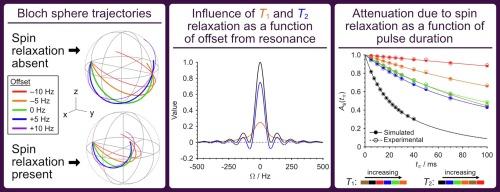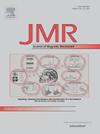合理解释切片选择性再聚焦脉冲期间的自旋弛豫。
IF 1.9
3区 化学
Q3 BIOCHEMICAL RESEARCH METHODS
引用次数: 0
摘要
切片选择性再聚焦脉冲是当代磁共振实验的强大组成部分,但由于其带来的与部位相关的信号损失,使其在定量应用中的使用变得复杂。这种衰减的来源之一是脉冲期间发生的自旋弛豫,其造成的损失取决于特定共振的特定纵向和横向弛豫时间常数。射频脉冲的任何振幅整形以及空间编码脉冲场梯度的存在都会使这种依赖性变得复杂。空间编码脉冲场梯度会导致测量到的净信号是来自共振的连续偏移信号的加权和。一般来说,每个偏移都会对整体信号产生不同的贡献,并会被不同的纵向和横向弛豫混合衰减,而这是由核磁化在实验过程中的不同轨迹决定的。尽管这种行为很复杂,但我们从实验和数值模拟中获得的证据表明,在实际实验应用中,可以使用相对简单的经验函数来准确预测切片选择性再聚焦脉冲过程中的弛豫衰减。在定量应用切片选择脉冲方法(如 Zangger-Sterk 纯移位 NMR)时,这种方法可用于校正弛豫损失。本文章由计算机程序翻译,如有差异,请以英文原文为准。

Rationalising spin relaxation during slice-selective refocusing pulses
Slice-selective refocusing pulses are powerful building blocks in contemporary magnetic resonance experiments, but their use in quantitative applications is complicated by the site-dependent signal loss they introduce. One source of this attenuation is the spin relaxation that occurs during such pulses, which causes losses that depend on the specific longitudinal and transverse relaxation time constants for a given resonance. This dependence is complicated both by any amplitude shaping of the radiofrequency pulse, and by the presence of the spatial encoding pulsed field gradient. The latter causes the net signal measured to be the weighted sum of signal contributions from a continuous range of offsets from resonance. In general, each offset will make a different contribution to the overall signal, and will be attenuated by a different mixture of longitudinal and transverse relaxation that is dictated by the different trajectories that the nuclear magnetisations take during experiments. Despite this complex behaviour, we present evidence from experiments and numerical simulations showing that in practical experimental applications a relatively simple empirical function can be used to accurately predict relaxational attenuation during slice-selective refocusing pulses. This approach may be of practical use in correcting for relaxational losses in quantitative applications of slice-selective pulse methods such as Zangger–Sterk pure shift NMR.
求助全文
通过发布文献求助,成功后即可免费获取论文全文。
去求助
来源期刊
CiteScore
3.80
自引率
13.60%
发文量
150
审稿时长
69 days
期刊介绍:
The Journal of Magnetic Resonance presents original technical and scientific papers in all aspects of magnetic resonance, including nuclear magnetic resonance spectroscopy (NMR) of solids and liquids, electron spin/paramagnetic resonance (EPR), in vivo magnetic resonance imaging (MRI) and spectroscopy (MRS), nuclear quadrupole resonance (NQR) and magnetic resonance phenomena at nearly zero fields or in combination with optics. The Journal''s main aims include deepening the physical principles underlying all these spectroscopies, publishing significant theoretical and experimental results leading to spectral and spatial progress in these areas, and opening new MR-based applications in chemistry, biology and medicine. The Journal also seeks descriptions of novel apparatuses, new experimental protocols, and new procedures of data analysis and interpretation - including computational and quantum-mechanical methods - capable of advancing MR spectroscopy and imaging.

 求助内容:
求助内容: 应助结果提醒方式:
应助结果提醒方式:


